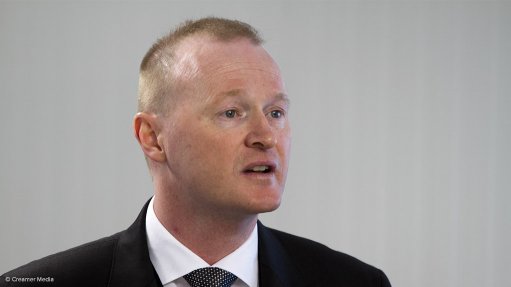
Medupi power station project director Roman Crookes
Photo by: Duane Daws
Medupi power station project director Roman Crookes says several actions have been taken to transfer lessons from the much delayed commissioning of Unit 6 to the other five 794 MW units, which will be introduced in stages between 2017 and 2020.
The R105-billion, 4 764 MW Limpopo-based power station has faced serious technical and labour disruptions since construction began in 2007, delaying the project by about four years.
The first unit, or Unit 6, first began feeding power into the grid in March and has been producing at full load since May 26, 2015. However, it officially entered commercial operation on August 23.
Medupi is being built in reverse order in terms of Eskom’s right-to-left nomenclature when viewing its coal-fired power stations with the units in front of the stacks. The decision to reverse the order at Medupi was based on the discovery of a rock conglomeration on the southern side of the site, which made it more cost effective to build from left to right.
Crookes says Unit 6 has contributed materially to the reduction in load-shedding incidents, having ramped-up steadily from feeding 20 277 MWh into the grid in March, to 352 676 MWh by August.
During September the unit’s contribution rose further to 387 535 MWh despite heat-wave conditions, indicating that Medupi’s updated air-cooled-condenser design made it less prone to the vacuum losses associated with it neighbouring dry-cooled plant, Matimba.
The focus of the project team had since shifted to ensuring the introduction of the subsequent units, which would collectively add nearly 4 000 MW.
Crookes says the actions taken to accelerate Units 5 include:
- a strengthened quality of governance and management team, which has been beefed up with the assistance of Balfour Beatty;
- tightened controls and oversight on contractor performance through the introduction of a daily forum to escalate and resolve construction issues, the initiation of independent quality reviews to avoid defects and the creation of a chief executive productivity forum;
- the stepping up of project controls to manage schedule and cost revisions;
- strengthened industrial relations;
- embedded project supervision; and
- the implementation of a holistic claims and contractor management strategy.
Crookes says detailed information relating to the claims submitted by contractors was subject to confidentiality, but indicates that 92% of the claims submitted have been resolved.
On why the schedule could not be accelerated further in light of the lessons learned during the building of Unit 6, Crookes explains that some of the problems were “engineered” into the subsequent units and now have to be unraveled.
“When you start building a power station and all the products that go into it, the products are built fairly quickly on a production line. So by the time we discovered some of the problems it was already in at least two or three other units.”
Some of the technical problems with Unit 6’s boiler, for instance, had migrated across to Unit 5 and Unit 4 before they were discovered.
“The second component is that we want a reasonable separation between the introduction of the units. We can’t end up commissioning two units simultaneously, for resource capacity and logistical reasons,” Crookes explains, adding that developments on the Medupi site also need to be synchronised with progress being made on the 4 800 MW Kusile project, with a sharing or resources across sites.
“It’s an ongoing juggling match.”